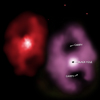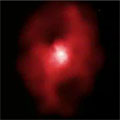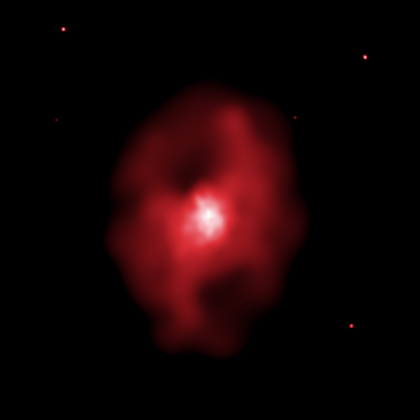Most Powerful Eruption in the Universe Discovered
This Chandra image shows two vast cavities - each 600,000 light years in diameter - in the hot, X-ray emitting gas that pervades the galaxy cluster MS 0735.6+7421 (MS 0735 for short). Although the cavities contain very little hot gas, they are filled with a two-sided, elongated, magnetized bubble of extremely high-energy electrons that emit radio waves.
The cavities appear on opposite sides of a large galaxy at the center of the cluster, which indicates that a gigantic eruption produced by the galaxy's supermassive black hole created the structures. The magnitude of the eruption suggests that as a large amount of gas swirled rapidly toward the central black hole, it generated intense electromagnetic fields that ejected a fraction of the gas in the form of powerful jets of high-energy particles.
As these jets blasted through the galaxy into the surrounding multimillion degree intergalactic gas, they pushed the hot gas aside to create the cavities. The mass of the displaced gas equals about a trillion Suns, more than the mass of all the stars in the Milky Way.
Chandra has discovered evidence of similar outbursts in the form of other X-ray cavities in galaxy clusters, but the cavities in MS 0735 are easily the largest and most powerful. To create such an enormous eruption, the supermassive black hole must have swallowed about 300 million solar masses of gas over the last hundred million years.
|
||||||||||||||||||||||||||||
A Chandra X-ray Observatory image of a cluster of galaxies, MS 0735.6+7421, is the subject. The image has a bright white dot in the center with dim pink splotchy shape around it, surrounded by hot red gas in a curved “H†shape. The red shape stands out prominently against the black background. This Chandra image shows two vast cavities (making up the hollows of the H shape). Each cavity, 600,000 light years in diameter, is in the hot, X-ray emitting gas that pervades the galaxy cluster MS 0735.6+7421 (MS 0735 for short). Although the cavities contain very little hot gas, they are filled with a two-sided, elongated, magnetized bubble of extremely high-energy electrons that emit radio waves. The cavities appear on opposite sides of a large galaxy at the center of the cluster, which indicates that a gigantic eruption produced by the galaxy's supermassive black hole created the structures. The magnitude of the eruption suggests that as a large amount of gas swirled rapidly toward the central black hole, it generated intense electromagnetic fields that ejected a fraction of the gas in the form of powerful jets of high-energy particles.






